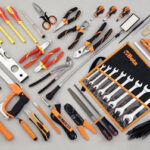How do skilled tradesmen obtain their skills? Learn how they are best employed in the modern day arena of highly automated machining, and why there will always be a need for skilled labor.
Why Become a Skilled Professional Tradesman?
To help understanding the role of the skilled tradesman in industry and construction, we should look at the traditional system of apprenticeship and the mastery of a skill. Loosely, there were three grades within a trade (but each grade might have had minor sub-grades). Generally the grades were:
· Master Tradesman
· Journeyman
· Apprentice
The Master Tradesmen could also hold the grade of Guild Master. This was very important to the participant because once a Master had been elected into his Guild, it almost always conferred the title of “Freeman” of the town, with all the additional benefits that this entailed. These were far more munificent in bygone days than they are today. (A similar honor in the U.S. today, would be a “Key to the City” award.)
Journeymen would generally be classed as Senior, Journeyman, and Junior. This was dependent on how long they had been out of their apprenticeships and, especially for Senior Journeymen, whether or not they were training masters for apprentices. The term “Journeyman,” although it has mainly fallen into disuse these days, was derived from the French “journèe”, meaning “of a day.” The reference is to “per diem” rate that the tradesman could legally charge for his work.
Apprentices would normally be classed by the year of their apprenticeship- first year, second year, etc.- and sometimes in their final year they would be termed a“Senior” or “Apprentice Journeyman”.
We have all probably come across the term “indentured”. This normally applied to a contractual document. There is nothing mysterious about it, although its meaning may have been forgotten in the mists of time. All apprentices were contracted. The terms of the contract, to safeguard both the employer and the employee, were then written out twice on a piece of paper, and the paper was cut in half with a random wavy line. This meant that the two pieces of paper could only be put together properly if all the “indents” fitted correctly. This was an early “security code” to identify each part of the original document; the apprentice would keep one part and the Master or the Trade guild would keep the other.
There were definite advantages to becoming a skilled tradesman. If you reached the top of your trade, you could be a freeman of your town or city. Once you had passed out of your apprenticeship, you were guaranteed a set rate of pay for your work.
Apprentices were well aware of these future benefits, which is why they were prepared to accept an extremely modest stipend while learning their trade. There was no minimum wage legislation in those days- in fact, not even in my day. (More’s the pity.)
It’s interesting that “The Worshipful Company of Turners” was the 51st Trade Guild to be granted livery in the City of London (circa 1604). Prior to this, the “Guild of Turners” was known to exist in 1310.
How Did One Become a Skilled Tradesman?

Virtually the only way to become a skilled tradesman was via the apprenticeship system. An apprenticeship for a Turning Tradesman would last approximately five years, during which time the apprentice was expected to learn, both in a workshop and classroom environment, all the skills and knowledge that would enable him to become a journeyman. These would include among others:
· Complete familiarity with the lathe, its functions and tooling
· Mechanics (especially gear ratios and drive trains)
· Basic physics (including force and power calculations)
· Arithmetic and mensuration (the “art” of measuring)
· Mathematics (to include trigonometry and algebra)
· Marking out
· Use of precision measuring instruments
· Basic metallurgy (including metal properties, compositions, and heat treatments)
· Knowledge of lubricants and coolants
· Basic draftsmanship and the ability to read drawings
· Use of data tables
· Basic toolmaking (including design)
Usually first and second year apprentices would be almost totally non-productive, spending about 75% of their time in the “training workshop” and 25% in the classroom. Having attained the basic skills, they would be seconded to a Senior Journeyman, probably for the remainder of their apprenticeship, who would act as their training master, tutor, mentor, and advisor, and would help them to hone and refine their skills and techniques. Classroom work would still continue, but to a lesser degree, and their “on the job training,” as they became more proficient, could allow the employer to perhaps see some return on the quite heavy investment that had been made in their training. Their final examination would normally require the production of a designated “test” piece or pieces that would require that they use and exhibit a majority of the knowledge, skills, and techniques that they had learned.
Is There Still a Role for the Skilled Turner?
My own opinion is a definite “Yes.” To qualify that opinion, let us look briefly at some of the tasks that skilled turners undertake.

Programming
After training, the average CNC machine can be programmed by almost anyone with some degree of computer literacy. However, what should be realized is that these machines, by their very design, are extremely powerful, so that they can handle the maximum capacity of material described in the machine specification. The program utilizes parameters that are developed from the properties of the materials, the tooling types, etc., and are set in the main machine program by the manufacturer. So, although these parameters are available to configure the machining dynamics for the work piece, e.g. its turning speed, depth of cut, feed rate, the required finish etc., as the parameters can be quite wide, the machine usually derives and applies a “happy medium.”
The skilled Turner however, can observe the machining process and will know that, for instance, the swarf generated by the cut is wrong, the depth of cut on the final roughing cut is too heavy for the finished diameter and is causing the work to bow away from the tool, or perhaps causing “chatter,” the finish is not correct, etc. By dint of his experience he can usually alter the program to produce the optimum result.
One Off and Prototyping
Unless a company is very large, with spare capacity on its production lines, normally it is taboo to take a high volume producer (like a CNC machine) off line for “one off” jobs or “prototype” manufacture. It is just not economical. With “one offs” the Skilled Turner is doing exactly what he trained for- producing high quality work on a lathe and thereby saving the production line from disruption. Similarly with “prototyping,” this can enable the design engineers to test and evaluate a part, introducing any modifications, material changes etc., that may be required. When the prototype is ready to upgrade to production status, it also allows the programmer to study and evaluate the part and write the best program for the CNC machine/s that will be tasked with production.
Rectification
Unfortunately, producing parts rapidly with an enclosed, automated, very powerful machine does not allow the operator to easily discern faulty production. To overcome this problem the operator is usually required to inspect, for instance, 5 pieces of every 100 produced. If he detects any faults in the production item, the machine is taken off line for the fault to be rectified. As an example, it could be a chipped tool that is producing a sub-standard finish. Further inspection will then establish just how many faulty pieces had been made. Depending on the economics of the situation, e.g. 5-10 lower cost items could justify “scrapping,” whereas 99 medium-expensive items, if they could be recovered, would be given to the charge of the Turner for rectification.
The Devil that is Diversity of Production
When parts are required for high volume, complex assemblies, as for example, automobiles, the sheer number of components will normally preclude all those items being produced by the same manufacturer. Several manufacturers will be sub-contracted to produce the various components, which will then be shipped back to the assembly line. The problem that then arises is to ensure that all those components will fit together correctly. An example could be a shaft that is to be fitted into a bearing. The shaft will have been manufactured to certain tolerances. Those tolerances will dictate that the shaft must not be undersize (slop in the bearing = scrap), but may be slightly oversize. This over-sizing could be caused if the shaft had to undergo heat treatment to harden it. For whatever reason, provided the shaft is within tolerance, it is still acceptable to the assembler and will be passed to the Turner, who will finish the shaft to the correct dimensions. This is an over-simplification of the process, but it conveys the idea of how it works.


